Photo Essay: Community-Based Monitoring and the Matilija Dam
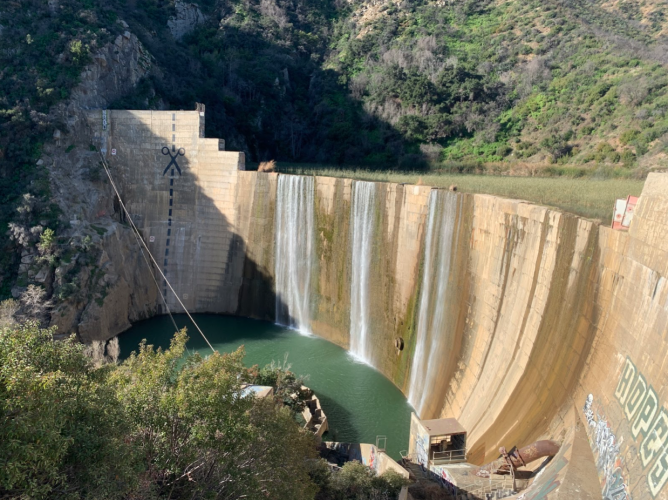 Removing the Matilija Dam will be no easy feat.
Standing at a height of roughly 168-feet, or about 15 stories
tall, this 73-year-old concrete structure blocks the flow of
Matilija Creek, a major tributary of the Ventura River in
Southern California.
Removing the Matilija Dam will be no easy feat.
Standing at a height of roughly 168-feet, or about 15 stories
tall, this 73-year-old concrete structure blocks the flow of
Matilija Creek, a major tributary of the Ventura River in
Southern California.
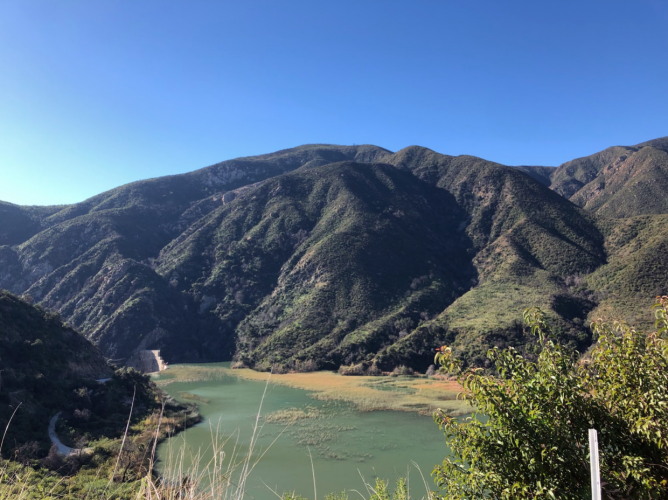 Heavy sedimentation in the reservoir above the dam
has effectively eliminated its capacity to provide the water
storage and flood control services for which it was originally
built. Some have even described its design as “flawed
from the outset.” Removing the dam has the potential to
revitalize sediment transport patterns and other ecosystem
processes that increase groundwater storage, restore downstream
beaches, and provide critical habitat to species like the
endangered
Southern California steelhead trout. Fundraising for the
removal is well underway, with local groups leading the charge to
come up with the $180 million necessary for the many project
components.
Heavy sedimentation in the reservoir above the dam
has effectively eliminated its capacity to provide the water
storage and flood control services for which it was originally
built. Some have even described its design as “flawed
from the outset.” Removing the dam has the potential to
revitalize sediment transport patterns and other ecosystem
processes that increase groundwater storage, restore downstream
beaches, and provide critical habitat to species like the
endangered
Southern California steelhead trout. Fundraising for the
removal is well underway, with local groups leading the charge to
come up with the $180 million necessary for the many project
components.
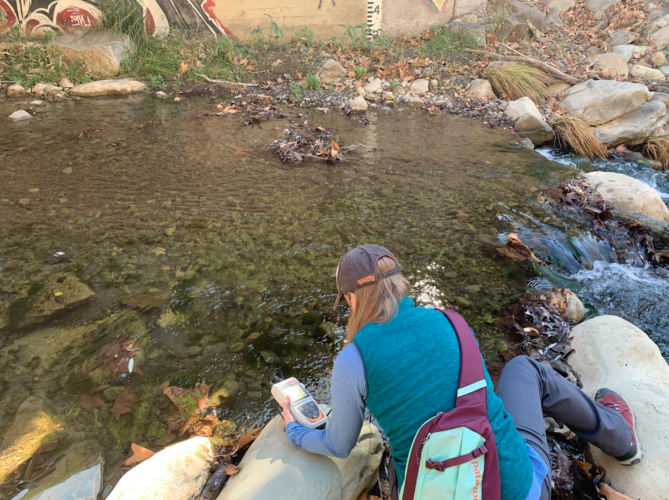 In any conservation or restoration project,
monitoring is an important way for scientists, resource managers,
and communities to learn about environmental conditions and take
action accordingly. While there is no formal monitoring program
in place related to the Matilija Dam removal, it’s not too early
to begin exploring the role that local communities can play that
process.
In any conservation or restoration project,
monitoring is an important way for scientists, resource managers,
and communities to learn about environmental conditions and take
action accordingly. While there is no formal monitoring program
in place related to the Matilija Dam removal, it’s not too early
to begin exploring the role that local communities can play that
process.
With support from the Open Rivers Fund, our team at the Center for Community and Citizen Science has been working with various partners in Southern California to build capacity for community-based monitoring. In addition to providing data on the watershed to inform dam removal efforts, community-based monitoring can also create opportunities for learning, community engagement, and stewardship. Beginning that work now can help to build a baseline of understanding, in advance of significant change in the watershed. It can also develop important experiential and practical knowledge that can plug into a formal program once the dam removal is closer at hand.
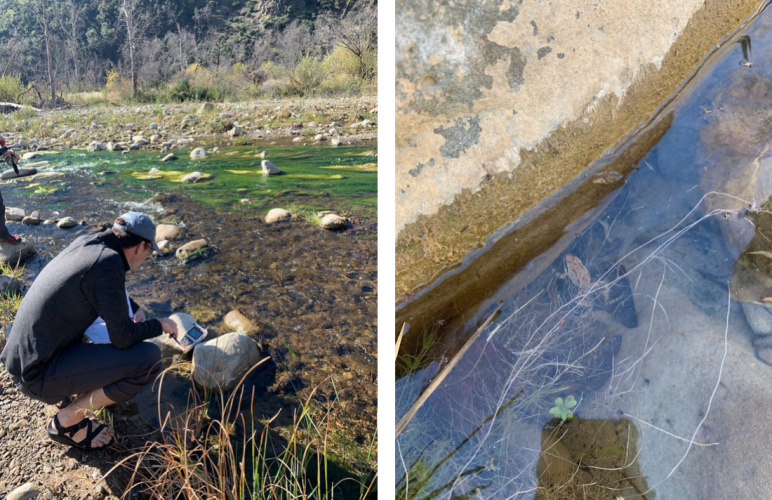 There are already some community-based monitoring
efforts underway in the watershed, and any new capacity-building
effort should take these into account. During a visit to Southern
California in February, 2020, we joined Santa Barbara Channelkeeper’s Stream
Team to participate in their water quality monitoring activities
at various sites along the Ventura River. Here, Ryan uses a water
conductivity sensor to assess water quality above the dam, which
will be recorded and inputted into a database that will allow
Channelkeeper to assess long-term trends. A Pacific chorus frog
decided to join our activities, and served as a reminder of this
watershed’s abundant biodiversity.
There are already some community-based monitoring
efforts underway in the watershed, and any new capacity-building
effort should take these into account. During a visit to Southern
California in February, 2020, we joined Santa Barbara Channelkeeper’s Stream
Team to participate in their water quality monitoring activities
at various sites along the Ventura River. Here, Ryan uses a water
conductivity sensor to assess water quality above the dam, which
will be recorded and inputted into a database that will allow
Channelkeeper to assess long-term trends. A Pacific chorus frog
decided to join our activities, and served as a reminder of this
watershed’s abundant biodiversity.
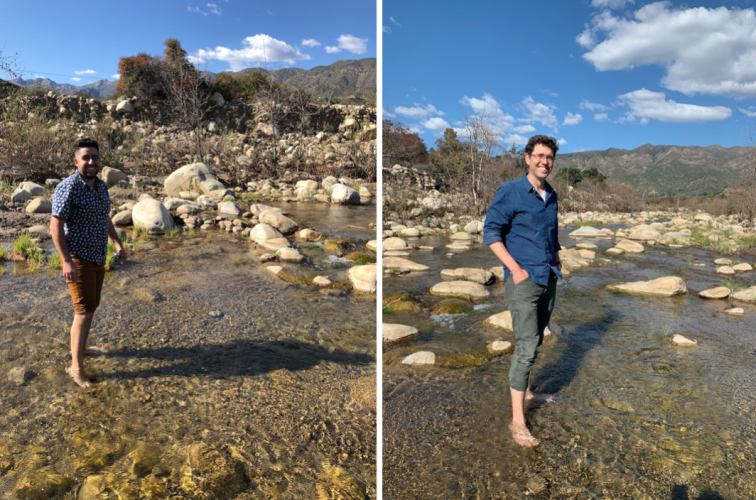 During a visit to the Ventura River Preserve,
managed by the Ojai Valley Land
Conservancy, we learned more about their work protecting and
restoring land throughout the region, and the potential role
community-based monitoring could play in that ongoing work. It
also provided a chance for team members Ryan and Chris to get
their feet wet – literally!
During a visit to the Ventura River Preserve,
managed by the Ojai Valley Land
Conservancy, we learned more about their work protecting and
restoring land throughout the region, and the potential role
community-based monitoring could play in that ongoing work. It
also provided a chance for team members Ryan and Chris to get
their feet wet – literally!
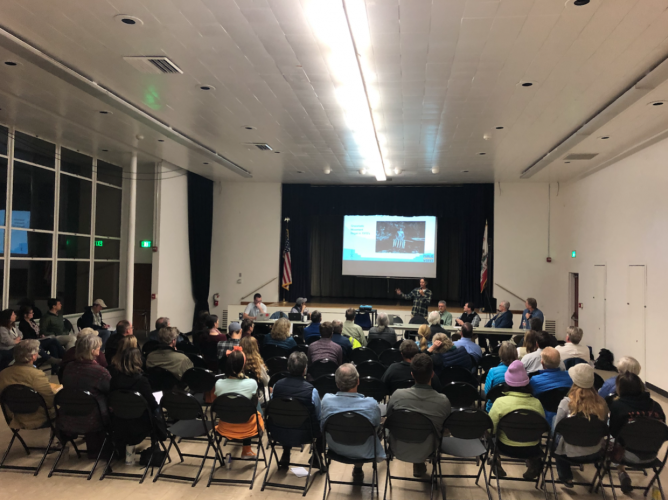 Dam removal efforts at this scale are enormously
complex, and not just from an engineering standpoint. At both
technical meetings and community town halls, like the event
pictured above, we learned more about engineering challenges,
fundraising updates, stakeholder interests, and the great variety
of partnerships required to move forward with this ambitious
project.
Dam removal efforts at this scale are enormously
complex, and not just from an engineering standpoint. At both
technical meetings and community town halls, like the event
pictured above, we learned more about engineering challenges,
fundraising updates, stakeholder interests, and the great variety
of partnerships required to move forward with this ambitious
project.
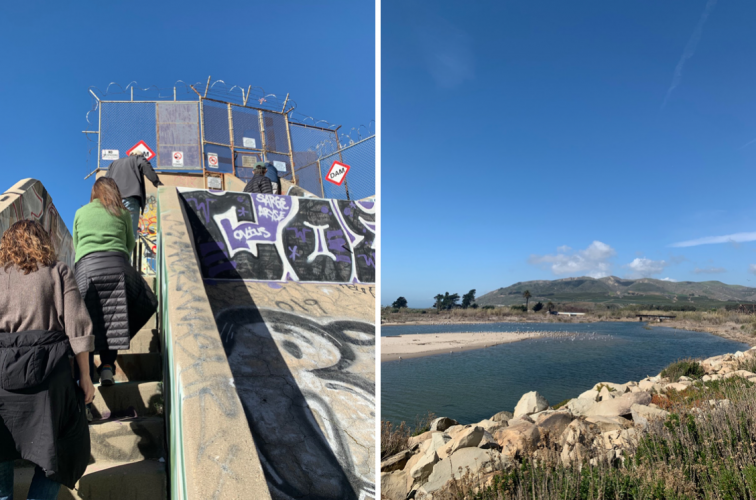 Project leaders took us on a tour of key sites in
the watershed related to dam removal. Tracing the length of the
Ventura River, we began upstream near the border of Los Padres
National Forest to see the dam itself, and ended downstream near
the ecologically important Ventura River estuary on the
coast.
Project leaders took us on a tour of key sites in
the watershed related to dam removal. Tracing the length of the
Ventura River, we began upstream near the border of Los Padres
National Forest to see the dam itself, and ended downstream near
the ecologically important Ventura River estuary on the
coast.
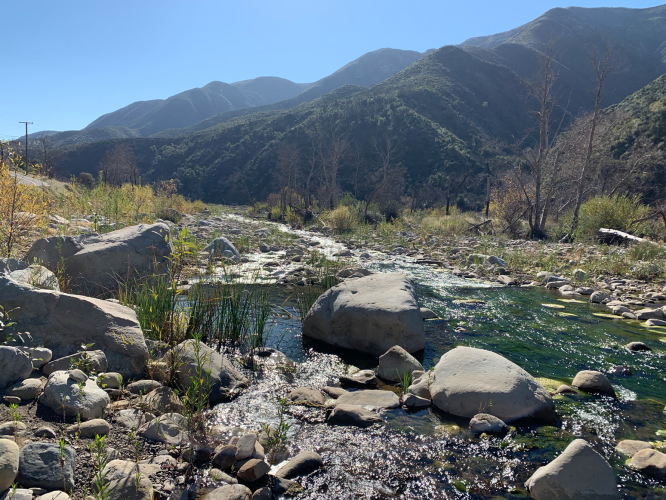 The Ventura River watershed is home to a large
number of schools and non-profits with an active interest in
environmental education. We’ve been meeting with educators,
including faculty from the Green Schools Coalition, a network of
seven different high schools who participate in environmental
advocacy initiatives in and around the Ojai Valley. We also met
with Once Upon a
Watershed, a project sponsored by the Ventura Land Trust that
provides watershed-focused educational programming to younger
students in the region. Our Center’s research has demonstrated the meaningful
science learning opportunities that can arise from youth
participation in community and citizen science.
The Ventura River watershed is home to a large
number of schools and non-profits with an active interest in
environmental education. We’ve been meeting with educators,
including faculty from the Green Schools Coalition, a network of
seven different high schools who participate in environmental
advocacy initiatives in and around the Ojai Valley. We also met
with Once Upon a
Watershed, a project sponsored by the Ventura Land Trust that
provides watershed-focused educational programming to younger
students in the region. Our Center’s research has demonstrated the meaningful
science learning opportunities that can arise from youth
participation in community and citizen science.
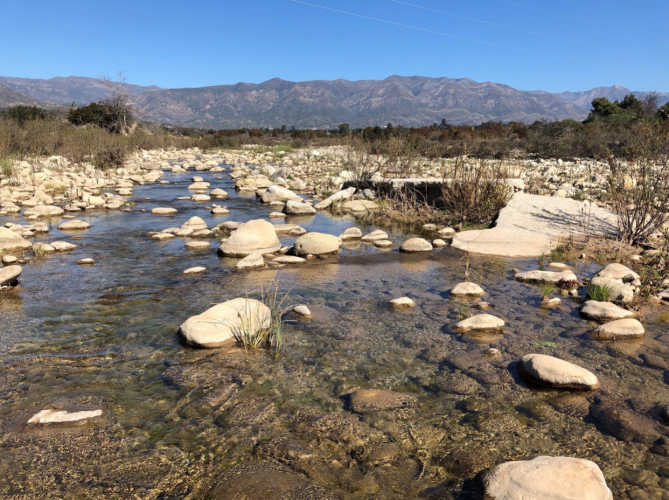 These site visits and meetings provided a foundation
for our multiple upcoming collaborations with community
organizations in the watershed over the course of the next year.
In the upper watershed, we will be partnering with the Green
Schools Coalition to support students in designing youth-led
monitoring projects that are responsive to both community and
scientific priorities. We will also be partnering with the
MERITO Foundation
in the lower watershed to develop a field-trip based model in
which middle and high school students and teachers in Ventura
collect and analyze data related to the dam removal effort as
part of a place-based science curriculum. Working with
stakeholders like the Ojai Valley Land Conservancy, Santa Barbara
Channelkeeper, Ventura Land Trust, and Watershed Progressive
as part of these efforts will link monitoring with watershed
stewardship restoration. We are excited to spend this time
building capacity for community-based monitoring as a means to
connect science, conservation, and communities in Ventura County
in the year ahead!
These site visits and meetings provided a foundation
for our multiple upcoming collaborations with community
organizations in the watershed over the course of the next year.
In the upper watershed, we will be partnering with the Green
Schools Coalition to support students in designing youth-led
monitoring projects that are responsive to both community and
scientific priorities. We will also be partnering with the
MERITO Foundation
in the lower watershed to develop a field-trip based model in
which middle and high school students and teachers in Ventura
collect and analyze data related to the dam removal effort as
part of a place-based science curriculum. Working with
stakeholders like the Ojai Valley Land Conservancy, Santa Barbara
Channelkeeper, Ventura Land Trust, and Watershed Progressive
as part of these efforts will link monitoring with watershed
stewardship restoration. We are excited to spend this time
building capacity for community-based monitoring as a means to
connect science, conservation, and communities in Ventura County
in the year ahead!








